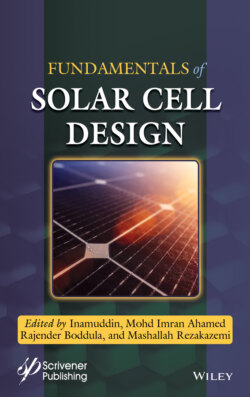Читать книгу Fundamentals of Solar Cell Design - Rajender Boddula - Страница 15
1.3 Solar Cell Structure
ОглавлениеFundamental steps occurring in a schematic representation of a typical solar cell device and its functioning are schematically provided in Figures 1.2 and 1.3. (a) Typical OSC devices based on donor-acceptor in bulk hetero-junction configuration, another way it is the sandwich of active organic blend material in between anode and cathode electrodes with light absorbing property. (b) Donor-acceptor hetero-junction solar cells with basic steps involved: 1) Photo-excitation of the donor-acceptor blend to generate an exciton/excited state [radicalanion/electron–radicalcation/ hole pair bound by ionic and radical (Coulomb) interactions]. 2) Exciton/ excited state diffusion to the donor-acceptor interface. Excitons/excited states that do not reach the inter-face, they recombine and do not contribute to the photocurrent (longer diffusion length, LD). 3) Dissociation of bound excitons at the donor-acceptor interface to form a geminate radical-anion (electron)–radical-cation (hole) pair [increased interfacial charge separation requires optimal energy offset between LUMO (lowest unoccupied molecular orbital) of the donor and LUMO of the acceptor material]. 4) Free charge carrier transport and collection at the external electrodes (require high charge-carrier mobility). (c) Fundamental processes (light illumination, exciton formation, charge separation, charge migration, and charge collection) of bulk-heterojunction solar cells (p = donor material, n = acceptor material).
Figure 1.2 Typical solar cell.
Figure 1.3 Possible events present in BHJOSCs.
